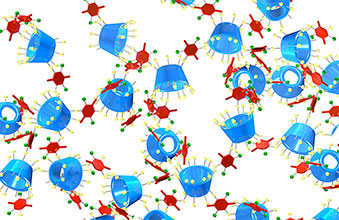Multimedia Gallery
Porous material made from cup-shaped cyclodextrins
A porous material made from cup-shaped cyclodextrins, which rapidly bind pollutants and remove them from contaminated water.
More about this image
At researsch team at Cornell University used the same material found in Febreze air fresheners, cyclodextrin, to develop a technique that could revolutionize the water-purification industry.
The team, which was led by Will Dichtel, an associate professor of chemistry and chemical biology and a 2015 MacArthur Foundation Fellowship winner, invented a porous form of cyclodextrin that has displayed uptake of pollutants through adsorption at rates vastly superior to traditional activated carbon -- as much as 200 times greater in some cases.
"What we did is make the first high-surface-area material made of cyclodextrin, combining some of the advantages of the activated carbon with the inherent advantages of the cyclodextrin," says Dichtel. "When you combine the best features of those two materials, you get a material that’s even better than either class. These materials will remove pollutants in seconds, as the water flows by, so there’s a potential for really low-energy, flow-through water purification, which is a big deal."
The cyclodextrin-containing polymer features easier, cheaper regeneration, so it can be reused many times with no observed loss in performance.
Support for the work came from the National Science Foundation (grant CHE 14-13862) through the Center for Sustainable Polymers, which brings together a diverse team of researchers from Cornell, the University of Minnesota and the University of California, Berkeley, to discover high-performance materials from sustainable, non-petroleum-based sources.
To learn more, see the Cornell news story Polymer breakthrough could revolutionize water purification. (Date image taken: November 2015; date originally posted to NSF Multimedia Gallery: March 7, 2016)
Credit: Dr. Michio Matsumoto, Cornell University
See other images like this on your iPhone or iPad download NSF Science Zone on the Apple App Store.
Images and other media in the National Science Foundation Multimedia Gallery are available for use in print and electronic material by NSF employees, members of the media, university staff, teachers and the general public. All media in the gallery are intended for personal, educational and nonprofit/non-commercial use only.
Images credited to the National Science Foundation, a federal agency, are in the public domain. The images were created by employees of the United States Government as part of their official duties or prepared by contractors as "works for hire" for NSF. You may freely use NSF-credited images and, at your discretion, credit NSF with a "Courtesy: National Science Foundation" notation.
Additional information about general usage can be found in Conditions.
Also Available:
Download the high-resolution JPG version of the image. (539.1 KB)
Use your mouse to right-click (Mac users may need to Ctrl-click) the link above and choose the option that will save the file or target to your computer.



